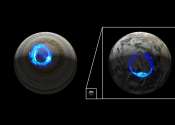Ocean physics explain cyclones on Jupiter
Hurtling around Jupiter and its 79 moons is the Juno spacecraft, a NASA-funded satellite that sends images from the largest planet in our solar system back to researchers on Earth. These photographs have given oceanographers ...









